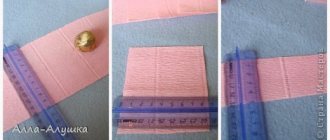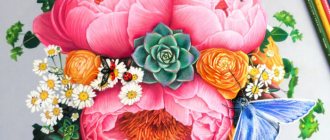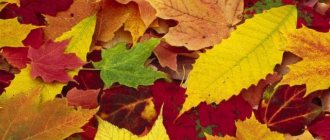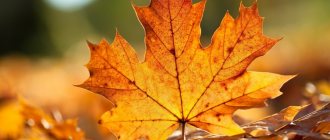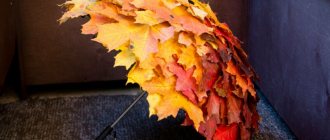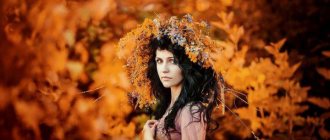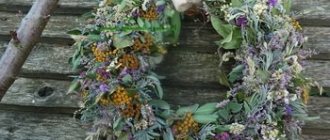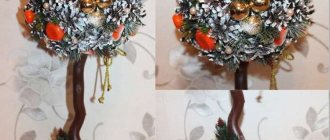With the arrival of autumn, some parents of children and primary schoolchildren tremblingly await the call: “Bring a craft made from autumn tree leaves.” These can be flowers, panels, appliqués, topiaries, voluminous crafts and other unique things. Of course, we’re not talking about creative moms and dads who turn everything they set out to do with their own hands into a masterpiece. And about those who have only a rough idea of creativity. Their similar phrases, school competitions, and seasonal talent shows plunge, if not into panic, then into despondency. Those who are in the middle seem to be able to depict something, but creative imagination is not enough, sometimes a hint on how and in what direction to move is enough, ready - the creative idea is embodied.
Creating flowers from autumn leaves will suit all of the above categories of parents. Professionals can make masterpieces on this basis, and novice masters or complete amateurs will understand that even a four-year-old can do this. The main thing is to look at the step-by-step instructions with detailed steps, and then practice several times. Fortunately, autumn foliage is not a material that will quickly run out or be expensive for the family budget. You can replenish its reserves over many days. And after practicing several times, you can turn this activity into a hobby.
Preparing for the creative process
Before collecting such flowers, you need to stock up on leaves. It is best to do this in the forest, or at least in the depths of a large park. Forest foliage is very fragrant, clean, harmless; from spring to autumn it did not absorb exhaust gases from urban transport and hazardous industries. There were no crowds of dogs walking with their owners here. Crafts are most often done together with children, so we choose the most environmentally friendly material.
The leaves that lie in the forest under your feet are also suitable for crafts. But it is better if they are plucked from a branch. While the leaf is still alive, even if yellow, is on the tree, it retains its natural moisture, density, and glossy shine. The fallen one lacks these properties, and it can simply be dirty. Even if you wash and dry it at home, it will become tiny and brittle. When working with such material, it is difficult to achieve natural rounded lines.
What leaves are roses made from?
Unfortunately, any leaves are not suitable for creating exclusive roses. You need to choose wide leaves that will not tear at the first touch, but also that they are not too hard.
The following foliage is ideal for this craft:
- maple;
- linden;
- viburnum;
- oak;
- poplar;
- rowan;
- elm
When collecting leaves for crafts, it is important to think through the color scheme in advance and select foliage according to tone.
Which tree leaves are suitable?
You can make a craft or applique from any material, but to create flowers, the material should be carefully selected in advance. The following tree species are most suitable for this purpose:
- maple;
- ash;
- poplar:
- birch;
- willow;
- Linden;
- viburnum;
- wild grapes.
Yellow, red, and green leaves are collected for crafts. Be sure to find several mixed colors: yellow-green, orange-red, purple-lilac or red-yellow. They will give the collected flower a natural charm and naturalness. If the craft is collected from the leaves of one type of tree, then they must take different sizes, from the smallest to the largest. Due to the difference in size, they also achieve naturalness and texture of the product.
From large leaves you can collect a large rose or chrysanthemum, and from small leaves you can make small pink buds. Large ones are useful for creating a cuff, and narrow and small ones for sepals.
How to make a rose from leaves with your own hands
The main thing in this craft is the leaves themselves. Collect specimens that are not torn, not overdried, and aesthetically beautiful. Before you start creating a flower, wash the leaves thoroughly and lay them on a towel to dry. Don’t dry it, just let it dry a little and you’re good to go. In addition to the foliage, you will need thin wire and a small stick to make it easier to create the center.
- Take one leaf and wrap it around the outside of a stick or thin twig of the same tree. This will be the middle.
- Wrap the second leaf around the first. Continue to bend the leaves around the middle, forming a rose. One rose requires an average of 19 chokeberry leaves.
- Wrap the base of the flower with thin wire.
- Gently straighten each leaf, bending its top outward.
The rose is ready. By making several of these roses you can form a bouquet or other composition.
Preliminary processing
The life of a craft made from unprocessed leaves will last about 2-3 weeks, and prepared materials are more durable. Wipe even leaves without holes or dark spots with a slightly damp sponge to remove dust, cobwebs or other small particles. Dissolve 0.6 liters of water and 0.3 liters of glycerin in a bowl. Put the mixture on the fire, bring to a boil, cool to room temperature. Stir thoroughly and pour into a deep plastic container. We immerse the peeled leaves in this solution, stems down, to a level of 7-8 cm, and seal tightly with a lid. Place in a cool, dark place away from sunlight.
For complete processing, it is necessary to keep the material in this solution for 10 to 14 days.
The more “meaty” and denser the leaf, the more time it needs. You can tell that it has been saturated with glycerin by the drops of dew that form on a wide surface. After this procedure, they become flexible, soft, elastic and glossy. This will affect the appearance of the finished flowers and extend the life of the craft by months.
When the natural material is removed from the container with glycerin, it must be dried. To do this, wipe the surface with a soft cloth, leave it to dry in its natural state for a couple of days, or hang it with cuttings on a string using clothespins. You can try ironing it through two layers of thick paper or fabric. But this method is not so good; it is used when the time for preparing natural material is limited. Natural drying will more effectively preserve softness and glossy shine.
When there is little time and there is definitely not enough time to do such a long pre-treatment, the leaves are simply washed and left to dry a little. And the finished product is sprayed with colorless hairspray to fix and add shine. There is a second method: using a soft brush with long bristles, the finished product is coated with a layer of sunflower oil. In a day or two it will be absorbed into the structure. The product will not be greasy, but will remain shiny for a long time.
Leaf treatment
So you collected and brought the leaves home. Is it possible to make a bouquet out of them now? No, unfortunately, it’s worth holding off for now.
If you want to make natural and elegant flowers from tree leaves, the instructions described below must be followed.
At the preparatory stage, the leaves should be thoroughly cleaned. And simply washing them in hot water will not be enough.
To properly prepare material for crafts, you should follow these steps:
- Start by filling a small basin with warm (but not hot) water.
- Add a little liquid soap there (the main thing is not powder, it will damage your leaves, and as a result the bouquet may not work out).
- Stir until the soap is completely dissolved in the water and add the collected leaves.
- Wait a few minutes (5-7 will be enough), catch the leaves and rinse them under the tap in slightly cool water.
- Now treat the leaves by placing them in a tight bag filled with a solution of glycerin mixed with water in a 1:2 ratio. Place your herbarium in this form in a cool, dark place for 3-4 days. This procedure is necessary so that the leaves acquire firmness, elasticity, and shine.
- After the required time has passed, remove the leaves from the bag, place them carefully on a towel and let them dry completely.
Master class on assembling roses from maple leaves
A trip to the park or a trip to the forest on sunny autumn days should be spent productively. While walking and enjoying nature, remember that materials for crafts should always be ready. Involve the children, start collecting natural resources according to plan: collect colorful leaves, cones, acorns, bunches of berries. All this will be useful for school and kindergarten crafts.
To create three rose flowers you will need:
- yellow-green maple leaves of different sizes 40-60 pcs.;
- thuja twigs;
- threads
Step-by-step instructions for assembling roses:
Iron the clean leaves through two layers of thick fabric and place them on the table.
From the first, not the largest, we form the middle. We fold it with the front side in half, that is, so that the natural back part is inside. We turn the sharp corner into the middle and tightly roll the tight core, as shown in the photo.
We take the second one and also fold it in half. We bend the sharp edges inward and wrap the middle.
We place each next one slightly lower than the previous one. Repeat until the product takes the shape of a flower.
When we use leaves of different colors, it gives life to the craft.
When the shape of the flower resembles a living bud, attach it from below using regular thread. Pull it tight, making sure the inner petals are held tightly.
We twist 2 more roses. We make a cuff from the remaining material.
We decorate the bouquet with small thuja branches.
We wrap the lower cuttings tightly with thread.
If you have prepared green adhesive tape and a dense twig, then with their help you can create the illusion of a rigid stem. To do this, carefully insert a branch into the middle, and then wrap adhesive tape along the entire length.
If there are branches of rowan or viburnum at home, they will enliven such a bouquet and complement it with bright notes.
Forming the core of a rose from tree leaves
It is only at first glance that it seems that only professional and experienced needlewomen can build such beauty. Not at all!
Believe me, following the instructions presented in the article, even a child can make almost any flowers from tree leaves!
The master class is very detailed, the description of the process is clearly described step by step. Read it. You will definitely succeed!
To form the core of a future rose, you must keep in mind the following:
You remember that the core of a rose has small petals, and the rose bud is framed by lush and wide ones? When making your own flower, you should follow the same principles. That is why you should start with the smallest leaf.
Take it and carefully bend it in half so that the outer side of the leaf is inside, and the top of the leaf and the tail (stick) are connected.
Happened? Great! Now roll the resulting structure into a tube. The core of the rose is ready!
Master class on assembling roses from birch leaves
Birch leaves are very soft, pliable and slightly velvety. Their flexible texture allows you to create smooth lines, and if you use scissors to give them a rounded shape, you get an unexpected result. Let's collect materials and tools:
- birch yellow leaves 20 pcs. – 7-8 pcs. for one rose, but it’s better to collect more;
- thread for fixation;
- sharp scissors;
- green leaves plucked from the stem of a natural rose.
Steps with photos of each stage:
Let's lay out the natural material on the table and sort it by size. The smallest ones will go to the middle.
Using scissors, we cut off the upper pointed edge of the birch leaf.
We overlap the 4 prepared rounded parts with the front side facing us.
We roll them up into a little ball, the bottom of which is narrower, and the edges widen at the top. This will be the middle.
We gradually add the following elements.
We tie it with thread.
Repeat for another 3-4 layers. We bend the outer upper edge of two or three petals outward, giving the appearance of a real flower.
We decorate the bottom with the leaves of a living rose.
If you wrap a twig at the bottom and decorate it with green adhesive tape, you will get an almost real rose. If left without a stem, then this craft can be used to decorate a picture frame or add it to another plot. Brush the petals with a wide brush dipped in sunflower or burdock oil. Leave it to dry away from the radiators. The next day the oil will be absorbed, and the craft will be glossy and fresh. This treatment will prevent the top edge from shrinking.
How to make a bud of a future rose
Well done! If you now have the middle of the rose in your hands, it means that you have practically mastered the simple technology. You have successfully figured out how to start making flowers from tree leaves with your own hands.
Now you can start forming the rose itself.
To form a rose, you should:
Take the next leaf a little larger.
Do the above procedure with it.
And, carefully applying it to the first tube, wrap it around it once.
This is interesting: Did Nyusha give birth to a child?
Repeat the manipulations with 3-4 more leaves.
Carefully fasten the tails (sticks) of your leaves with thread.
That's all, the rosebud is ready! Not difficult at all, right?

